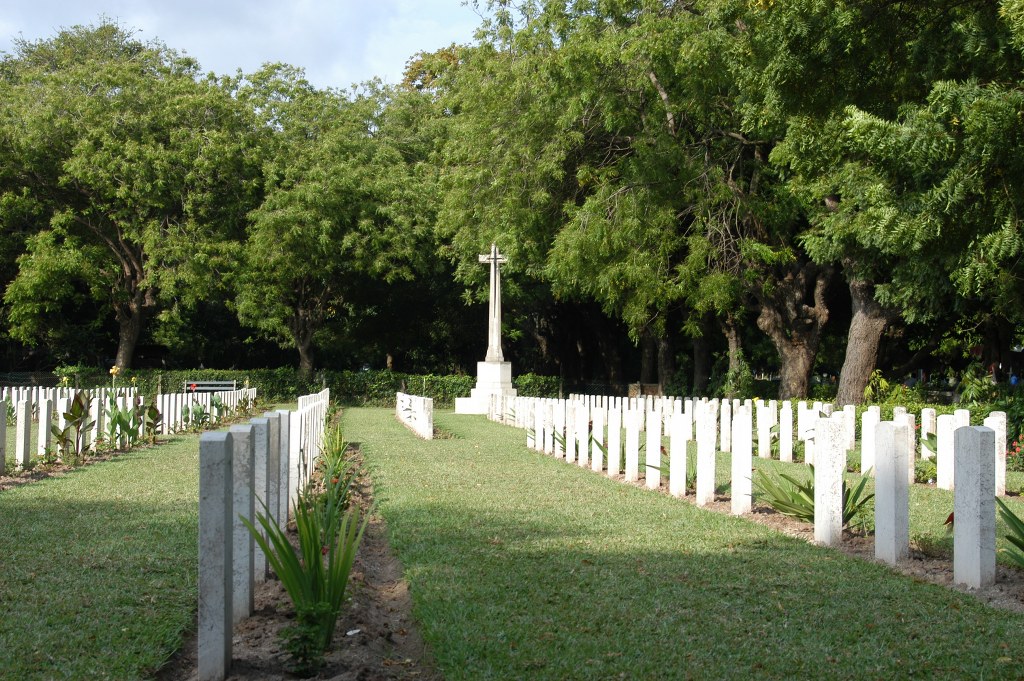Christiansborg War Cemetery
- Country Ghana
- Total identified casualties 418 Find these casualties
- Identified casualties from Second World War
- GPS Coordinates Latitude: 5.5537, Longitude: -0.19022
A 'family' reunion

Christiansborg WAR CEMETERY
Location: Accra, Ghana Language: English Altitude: 14m Rainfall: 809mm
Temperature: 22°c - 32°c Biggest challenge: Spread out team
A staff get-together sounds like a simple enough job. You can meet up with some of your colleagues and exchange stories, tips and tricks.
For the Commonwealth War Graves Commission’s team in West Africa, a meeting is a truly international undertaking. It involves linking gardeners who normally work more than 1,500 miles apart.
For some, it was the first time they had ever left their home country.
But that’s just what we did, in the fresh green surroundings of Christiansborg War Cemetery, in Ghana. Gardeners and caretakers from as far away as The Gambia and Nigeria huddled around to learn from some of our in-house experts.

Ideas and practices are discussed and shared.
This is the practical reality of how you make war cemeteries on every continent except Antarctica have the same look and feel. You have to get together and talk.
Horticultural excellence doesn’t happen by accident. The Commission has a wealth of experience in its workforce and that experience must constantly be passed down and shared.
This was our first African conference on this scale, and the hosts were our gardeners in Accra, the capital of Ghana.

Practical demonstrations back up the theory.
The lush plant life they look after was a great example for their colleagues from further afield. Vegetation grows incredibly quick in this part of the world and needs constant, careful attention.
In Nigeria, thanks to improvements to infrastructure, we will soon be able to introduce border planting, bringing more colour and life to our war cemeteries there. Showing those staff first-hand what they will soon need to do was an invaluable experience.
Inevitably, between training, our teams get talking. Sharing jokes, friendly competition about whose site looks best, and the obligatory stories of their commute; a two-day drive, the first-ever time on an aeroplane.
One Gambian gardener begins to recall how he followed in his father’s footsteps to join CWGC seven years ago. In the words of Saihou Sanyang himself, it’s not just a staff get-together.
“We are one family.”

The lush vegetation found in Christiansborg War Cemetery.
Location information
Christiansborg, one of the main suburbs of Accra, is 3 kilometres east of the city centre on the main coast road. Christiansborg War Cemetery is on Castle Road, near the State Building, Accra International Conference Centre and Sports Stadium, and Black Star Square. It is adjacent to Christianborg Civil Cemetery.
Visiting information
ARRIVAL
The route to the cemetery is not signposted.
PARKING
The parking area for the cemetery is along a paved access track running through an expanse of grass. There are palm trees along the edges of the track.
The ground is firm and flat, the surface is brick paved. The route is edged with white painted kerbstones.
ACCESS, LAYOUT AND MAIN ENTRANCE
The cemetery is rectangular shaped
The main entrance is a large, covered structure over a flagstone paved area. The main gate is underneath the entrance structure, which is comprised of three separate metal gates. The central opening has a double latched gate.
There is a step up to the paved area from the track, with the height of the step is between 10 and 15 cm. The edge of the step is painted white.
The main gate is a mid-level (thigh height) gate approximately 3 metres wide. A double gate, approximately 1.5 metres wide opens both inward and outward.
There is a small step down to the main cemetery, with a narrow dirt strip separating the paved entrance area and the turf.
The cemetery Register Box is built into the left-hand wall of the entrance building.
The Christiansborg Memorial is part of the entrance building, located in the wall opposite the Register Box.
The Cross of Sacrifice is at the furthest point from the main entrance on the right-hand side of the cemetery.
The internal paths are grass, the ground is firm and flat.
ALTERNATIVE ACCESS
There are no alternative entrances into the cemetery; access is through the main entrance only.
ADDITIONAL INFORMATION
The cemetery is open Monday to Friday 0600 hrs to 1800 hrs.
History information
During the Second World War, Accra airport and other airfields in the Gold Coast and Nigeria, were of major importance to the Atlantic Ferry - a process whereby much needed aircraft were flown by American crews from factories in America, across the South Atlantic, to West Africa. At Accra, the aircraft were handed over to the Royal Air Force, fitted and tested after their long flight, then flown onwards to the Desert Forces in North Africa. A separate service run by the South African Air Force flew bombers south to the Cape.
No. 37 (Accra) Military Hospital was established at Accra during the war-time expansion of the Royal West African Frontier Force. Accra also contributed six Companies to the Gold Coast Home Guard, created in 1940 and disbanded in 1944.
CHRISTIANSBORG WAR CEMETERY was constructed in 1941 and was maintained by the Royal Engineers until taken over by the Commission towards the end of 1949. Graves from the following cemeteries have since been brought into this cemetery :
Takoradi African Public Cemetery - 82 burials.
Tamale African Cemetery - 43 burials.
Tamale European Cemetery - 5 burials.
There are now 416 Commonwealth burials of the Second World War in Christianborg War Cemetery, one of them unidentified. There are also three war graves of other nationalities and 18 non world war burials.
The CHRISTIANSBORG MEMORIAL, which forms the entrance to the cemetery, commemorates over 450 men of Gold Coast enlistment who died in West African territory during the Second World War, whose graves are unknown or are so situated that permanent maintenance is not possible.




